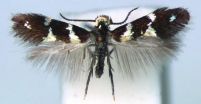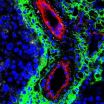(Press-News.org) One of the first large-scale genomic studies conducted in a developing country has discovered genetic variants that elevate the risk for skin lesions in people chronically exposed to arsenic. Genetic changes found near the enzyme for metabolizing the chemical into a less toxic form can significantly increase an individual's risk for developing arsenic-related disease.
The discovery could point the way to new screening and intervention options for people who are exposed to groundwater with high levels of arsenic, said scientists at the University of Chicago Medicine, Columbia University, and in Bangladesh in a study published in PLoS Genetics.
"These results add clarity to the genetic architecture that is playing a role in arsenic toxicity and its underlying biology," said senior author Habibul Ahsan, MD, MMedSc, Louis Block Professor of health studies, medicine and human genetics at the University of Chicago Medicine. "It's a rare type of study for a major problem affecting millions of people around the world, and it opens up opportunities for genetic studies of other major public health problems in developing countries."
The group's genome-wide association study, or GWAS, was conducted in nearly 3,000 individuals exposed to arsenic for decades in Bangladesh. Since the widespread installation of hand-pumped wells to tap groundwater sources in the 1970s, as many as 77 million people – about half the population of Bangladesh – have been accidentally exposed to dangerous levels of arsenic. The World Health Organization calls the exposure "the largest mass poisoning of a population in history."
For more than a decade, Ahsan and colleagues have studied the epidemiology of arsenic-related disease, such as skin lesions, diabetes, and respiratory illnesses, in this population, as well as the effectiveness of interventions to prevent toxicity. In the new study, funded by the National Institute of Environmental Health Sciences and the National Cancer Institute, the researchers sought genetic answers for why some individuals appear to be at higher risk for developing disease after arsenic exposure.
"Whatever the source of exposure, different individuals vary with respect to their susceptibility to the toxicity of arsenic," Ahsan said. "Even if they consume or are exposed to arsenic at the same dose and duration, some individuals will manifest toxicity phenotypes and others won't."
Researchers genotyped thousands of arsenic-exposed individuals from the group's main studies for single nucleotide polymorphisms (SNPs) throughout the genome, and looked for associations with arsenic metabolite levels and risk of skin lesions.
After ingestion, the body metabolizes inorganic arsenic into first monomethylarsonic acid (MMA) and then dimethylarsinic acid (DMA). MMA is considered to be more toxic, while DMA is water-soluble and more easily excreted. Higher levels of DMA or lower levels of MMA measured from an individual's urine are associated with lower toxicity.
A research team led by Ahsan and Brandon Pierce, PhD, an assistant professor of epidemiology at the University of Chicago Medicine, then used GWAS to search for SNPs associated with DMA and MMA levels. They found several significant genetic variants in the region of a likely candidate gene: arsenite methyltransferase (As3MT), an enzyme critical for arsenic metabolism. A second GWAS looking for SNPs associated with the development of skin lesions after arsenic exposure, pointed to many of the same variants. In a further study of gene expression levels, those same SNPs were associated with reduced expression of the arsenic metabolizing enzyme.
"This makes perfect sense," Ahsan said. "It gives us a very coherent story that we can now investigate in relation to other arsenic pathologies and in relation to a wide range of arsenic doses in this population."
"Now that we understand the molecular basis of some of this disease risk, it is conceivable to now think of incorporating this information into testing, evaluating, or potentially coming up with successful biomedical interventions," Ahsan continued. "By exploiting these metabolic pathways for a subgroup of individuals who will really be at higher risk for getting those diseases, we may be able to reduce fatal outcomes in this population."
The genetic findings provide strong evidence that efficient metabolism of arsenic through methylation protects against the toxin. Compounds that boost methylation, such as folic acid, could reduce arsenic toxicity – a strategy currently being tested by co-author Mary Gamble, PhD, associate professor of Environmental Health Sciences at Columbia University.
"If we could somehow find a way to do that in Bangladesh, it would make individuals much better methylators of arsenic, and as this current study shows if you're a better methylator you're at a lower risk for disease," said co-author Joseph Graziano, PhD, Professor of Environmental Health Sciences and Director of Superfund Research Program at the Mailman School of Public Health of Columbia University.
Risk variants may also help assess the potential toxicity of cancer chemotherapies which use arsenic or related compounds. SNPs associated with elevated sensitivity to arsenic toxicity could steer oncologists toward lower doses or alternative treatments in certain cancer patients, Ahsan said.
Beyond the clinical applications, the current study demonstrates that large-scale genomic studies are possible in a largely rural population of a developing country. The study offers a rare example of a GWAS result with clear, immediate potential for translational impact.
"Many genomic signals that we see are not robust enough or do not pertain to a large population," Ahsan said. "But in this study, that is not the case. The finding is robust, and the impact is massive."
###
The study, "Genome-wide association study identifies chromosome 10q24.32 variants associated with arsenic metabolism and toxicity phenotypes in Bangladesh," will be published online February 23rd by PLoS Genetics. For a full list of authors, see xxx.
Funding for the research was provided by the National Institute of Environmental Health Sciences and the National Cancer Institute.
For more news from the University of Chicago Medical Center, follow us on Twitter at @UChicagoMed, or visit our Facebook page at facebook.com/UChicagoMed, our research blog at sciencelife.uchospitals.edu, or our newsroom at uchospitals.edu/news.
END
Since in 2006 an unknown leafmining moth was found in North Italian vineyards by Mario Baldessari and colleagues, often in great numbers, scientists have tried to put a name to this apparently new invader. Italian scientists from the Fondazione Edmund Mach di San Michele all'Adige and the Università di Padova turned for help to taxonomists in the Netherlands and United States. The new species was described in the open access journal ZooKeys.
The family to which the moth belongs, the shield bearing leafminers (Heliozelidae) appeared to be poorly studied in North America, ...
Global Gaming Events launches another whopping $5,000 casino freeroll tournament with Casino Titan to be held in March 2012.
This event runs on Saturday, March 3rd, 2012 3pm ET to Sunday, March 4th, 2012 3pm ET. All players who have made at least one deposit or reload of a minimum of $50 during the month of February 2012 are eligible to play. Players must also pre-register for the event with Global Gaming Events to be eligible.
The tournament formats will be a 10 minute 5,000 Starting Chip Slot Tournaments and will have a maximum of 1000 players. Each player will ...
Researchers at the EPFL have identified an important mechanism that could lead to the design of more effective cancer vaccines. Their discovery of a new-found role of the lymphatic system in tumour growth shows how tumours evade detection by using a patient's own immune system.
Tumour cells present antigens or protein markers on their surfaces which make them identifiable to the host immune system. In the last decade, cancer vaccines have been designed that work by exposing the patient's immune cells to tumour-associated antigens and so priming them to kill cells that ...
Sani Beach Club is situated on its own stretch of private beach within Sani Resort on the beautiful Kassandra peninsula in Halkidiki, Northern Greece.
New Dining Options
There are three exceptional restaurants at Sani Beach Club - Dunes, Olympos and Ouzerie, each has redesigned its menu to offer guests a more traditional Greek gourmet experience. The new menu at Ouzerie has an innovative new twist that is similar to Sani Resort's famous new-age Greek restaurant Tomata. There will be a new Greek themed breakfast menu offering guests traditional morning specialities ...
Plants often regarded as common weeds such as thistles, buttercups and clover could be critical in safe guarding fragile food webs on UK farms according to Researchers funded by the Biotechnology and Biological Sciences Research Council (BBSRC).
Published tomorrow in Science, researchers from the University of Bristol detail the interactions that occur between the different food webs commonly found on farms throughout the UK and the robustness of these interactions to species loss. In one of the first studies to look simultaneously at multiple types of food webs, the researchers ...
GAINESVILLE, Fla. --- As scientists continue developing climate change projection models, paleontologists studying an extreme short-term global warming event have discovered direct evidence about how mammals respond to rising temperatures.
In a study appearing in Science Feb. 24, researchers from eight institutions led by scientists from the University of Florida and University of Nebraska found a correlation between temperature and body size in mammals by following the evolution of the earliest horses about 56 million years ago: As temperatures increased, their body ...
More than three quarters (77%) of cancer patients who first present to their family doctors (GPs) with suspicious symptoms are referred to hospital after only one or two consultations, a new study has found. However, the new research also shows a wide variation in the number of times a cancer patient sees their general practitioner before they are referred to a specialist, with the most pre-referral consultations occurring when the cancer was one of the less common types, or when the patient was either female, young, or an older person from an ethnic minority. The research ...
A compound in citrus fruits may reduce your stroke risk, according to research reported in Stroke: Journal of the American Heart Association.
This prospective study is one of the first in which researchers examine how consuming flavonoid subclasses affects the risk of stroke. Flavonoids are a class of compounds present in fruits, vegetables, dark chocolate and red wine.
"Studies have shown higher fruit, vegetable and specifically vitamin C intake is associated with reduced stroke risk," said Aedín Cassidy, Ph.D., the study's lead author and professor of nutrition at ...
Researchers at the RIKEN-MIT Center for Neural Circuit Genetics have discovered an answer to the long-standing mystery of how brain cells can both remember new memories while also maintaining older ones.
They found that specific neurons in a brain region called the dentate gyrus serve distinct roles in memory formation depending on whether the neural stem cells that produced them were of old versus young age.
The study will appear in the March 30 issue of Cell and links the cellular basis of memory formation to the birth of new neurons -- a finding that could unlock ...
Stavros "LOTSandLOTS" Ioannou, one of the latest up and coming poker players to be sponsored and mentored by Badbeat.com, has begun with a winning streak that started with two MTTs then, the following week, 2nd in the EUR5k guaranteed EUR50 Turbo on Poker Time and 3rd in the $10k Guaranteed $5 Rebuy on Poker Encore for $2.1k. Now bankrolled and tutored by Badbeat.com, prospects look good for the young poker player.
"My first day with Badbeat.com was a good one -- I played 6 MTTs in total and final tabled 3/6 winning two of them," said Ioannou. "My ...



